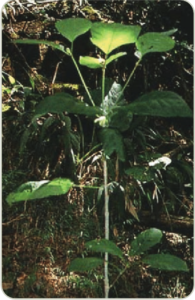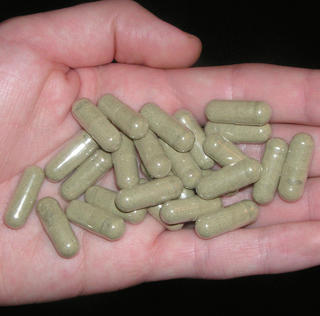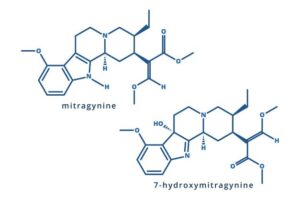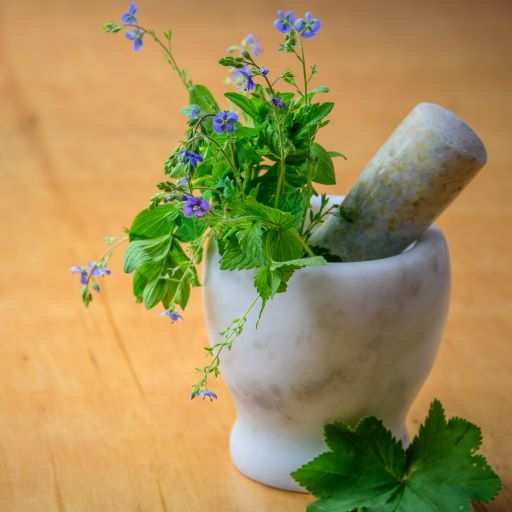“Never go to a doctor who’s office plants have died.”
– Erma Bombeck (American Writer and Humorist)
What’s the Story?
What Is Kratom?
The star of this article is Kratom (usually pronounced kraa-tum).
It is a tropical plant native to southeast Asia. Believe it or not, this herb is in the same plant family as coffee.
Its use in the West, particularly in the United States, has increased in recent decades. People who take Kratom say it has medicinal properties. This has come with some controversy because the plant is often used without medical supervision. Additionally, it has not been fully studied and there are safety concerns.

Coming up, we will look at the people and conditions that the plant may benefit. Then, we will cover the known risks and disadvantages of kratom use. Finally, we’ll talk about the places where it is legal and its current status as an herbal supplement.
I am just fascinated by medicinal plants. If you are too, check out this article on the Kava Root whenever you’re ready to learn more.
What Are the Benefits?
Why Do People Take Kratom?
In its native land of Southeast Asia, it has a long history of use as a medicinal plant. It was often taken to increase endurance. Use of kratom is believed to help with discomfort from tough physical work such as labor and farming.
These days, many people who take kratom regularly use it to help manage chronic conditions. According to a recent survey, these chronic conditions include physical pain like back pain. Also included are mental conditions like anxiety, depression, and post-traumatic stress disorder (PTSD).
How Kratom Is Used
The leaves of the plant are where the action is. People who use kratom believe that the color of the veins in the leaves help determine what effect it will have. The veins grow naturally in red, white, or green. According to one study, the red vein leaves may have higher potency.

Commonly, the leaves are used in two ways. They can be made into powder for use in capsules. Additionally, they can be made into tea to drink. This is called a decoction. In some traditional practices, kratom leaves are also chewed or smoked. For the record, smoking anything is inconsistent with health. Therefore, I don’t recommend smoking it.
How Kratom Works
Sometimes, plants that are not related make similar chemicals. For example, both tea and coffee are different plants that grow in different parts of the world. But they both contain caffeine. Kratom also has similarities with other medicinal plants. Studies have shown that its chemicals may share some properties with those of poppy flowers. Poppy flowers are the natural origin of opiate painkillers. However, kratom’s natural chemicals are in a different category. They are called alkaloids.
At low doses, people report that kratom has a stimulating effect. It produces alertness, increases stamina and endurance, and may improve mood. At larger doses, it reduces fever, pain, and produces some sedation.
Can Kratom Reduce Use of Opiate Painkillers?
Trials have shown that when animals get a dose of kratom it reduces their use of other opiates. Therefore, it is not surprising that some people use it for this reason. Many folks surveyed said that they used the plant to reduce their use of both prescription opioids like Percocet and illegal opiates like heroin. In fact, the majority of folks who used it for this reason reported that they stopped opiate use within six months. Nearly everyone who used kratom for this purpose said they would recommend it as an opiate withdrawal treatment. However, no medical studies have been done that prove it is useful for this purpose.
A Dose of Kratom
The science of kratom is still being evaluated. This means a standard effective dose is not currently available.
Some suggest doses of 500 to 750 milligrams are enough to have an effect. One study reported that people feel successful with an average dose of 2.5 grams. According to a survey of current users, people reported that doses of up to 5 grams three times per day were generally free from bad results. Toxicity and serious side effects have been reported in doses of 8 grams and up.
The effects of kratom may last for 5 to 7 hours. These effects are reported as strongest between 2 and 4 hours after use.
If you are going to use it, I recommend using the lowest possible effective dose. This is the same recommendation I have for all drugs and supplements. So start small and only take more if you do not notice the effect you need. In the case of kratom, I also recommend using it as rarely as possible. Many of this plant’s safety concerns affect people who use it often and in large doses.
What Are the Risks?
Is Kratom Safe?
Kratom has been used by humans for hundreds of years. However, that does not mean its use comes without risks. In many places, it is considered an herbal supplement rather than a medication. This causes two main problems.
First, the quality of herbal supplements are not watched as closely as medications. This means there may be concerns for the purity of the product. For example, in 2018 a bad batch of kratom caused a salmonella outbreak in the United States.
Second, herbal supplements do not have to be tested as strictly as medications do. This means there is an extremely small number of scientific studies that have been done with kratom on humans. Therefore, the information we have is not perfect and should be studied more.
Side Effects
Side effects from kratom tend to be mild. According to a survey, about 1 in 5 people who use it experience any side effects at all. Those who experienced side effects noticed that they were generally modest and lasted less than one day. The most common side effects reported included:
- nausea
- constipation
- dizziness
- drowsiness
More moderate reactions included things such as agitation, increased heart rate, and confusion. The most serious side effects seen occurred in people who take large doses and included seizures, hallucinations, and coma.
Abuse Potential
Animal studies have shown that Kratom has less potential for abuse than opiates like morphine. In a survey of people who use it, around 90% did not fit the standard medical definition for abuse.
However, there seems to be a relationship between people who report a lot of use and high doses with a withdrawal experience. Animal studies have also confirmed this finding. The survey of kratom users found that almost 1 in 10 had some form of withdrawal when they stopped using it.
Who Shouldn’t Use Kratom
Pause for Consideration:
Low abuse potential does not mean no abuse potential. Remember that kratom may not be appropriate for folks who are living with addiction, substance use disorder, or vulnerable to becoming dependent on any type of drug.
Additionally, folks who take medications which may harm the liver should take extra consideration before using kratom. There is also the risk that it interacts with your other medications. Always speak with your pharmacist or healthcare provider before adding a medication or supplement to your routine.
Finally, pregnant and breastfeeding women as well as children should avoid using kratom. We have very little information about how this supplement affects developing bodies and brains.
Legal Status
As kratom gains popularity around the world, new questions about whether or not to regulate its use come up.
Legal Status In the United States
In 2016 the Food and Drug Administration (FDA) attempted to ban the sale and possession of kratom. But due to public commentary, activism, and limited evidence of harm, the herbal supplement is still available for use and purchase in most states in the USA. However, it is illegal in several states and individual cities. Currently, the FDA advises consumers not to use it.

Kratom remains on the Drug Enforcement Agency (DEA)’s Drugs of Concern list. One reason for this is due to 44 deaths over a 10 year period linked to its use. These deaths typically occurred while folks were using it in combination with other drugs. For perspective, this number is 1,000 times smaller than the number of people who died from opiates in the United States in the year 2017 alone. Deaths linked to medications and supplements are entirely preventable. Further understanding about causes and solutions are necessary.
The National Institute on Drugs of Abuse (NIDA) is currently investigating if kratom can be used as a medicine. They fund research regarding its therapeutic use. Some of these studies investigate the plant’s ability to treat chronic pain, opiate withdrawal, and substance abuse disorder.
The American Kratom Association is an advocacy group which works on several things related to kratom. First, they offer education and awareness about the supplement and its use. They then promote legal access and track its legal status in each US state. Lastly, they offer opinions on the proper ways to manufacture and sell kratom.
Legal Status Around the World
In 2021 the World Health Organization (WHO) stated that there was not enough risk to include kratom on its list of international controlled substances.
In Europe, kratom remains legal in many places. However, it is illegal in several countries such as Ireland. Moreover, it is considered a controlled substance in the United Kingdom.
In places where the plant grows naturally, kratom has been recognized in different ways. For example, it is banned in Malaysia. In Thailand it is available for medical use.
Where to Get Kratom
Where kratom is legal, it has become easier to purchase. It can often be found in stores which sell other herbal medications and smoke shops. It is possible to find online retailers for the supplement as well but the rules for this vary depending on where you live. Be sure to know the laws for your area before buying kratom.
Final Thoughts
Kratom is an incredible plant. It has unique qualities and the potential to help humans live better. Therefore, I hope that we can do more research on this herbal product. It would be so valuable to understand its medical potential as well as its safety risks.
Based on the current evidence, I do not recommend kratom for any particular use. The reason is because I believe that we do not have enough data to form strong scientific opinions. However, I think especially during the ongoing opiate crisis, access to all information is important. And as a healthcare provider, it is my duty to provide that information, both the good and the bad. I hope you have enjoyed learning a bit about kratom with me.
Talk Nerdy to Me (Details for Professionals and Curious Minds)
Chemistry

The kratom plant, Mitragyna speciosa, is known to contain over 40 alkaloid compounds of which four are known to possess pharmacologic activity.
These are mitragynine, 7-hydroxymitagynine, speciocilatine, and corynantheidine. Mitragynine appears in the highest concentration at roughly 2%. These so-called indole alkaloids have been colloquially referred to as atypical opioids due to their distinct effect profile.
Pharmacodynamics
Kratom’s full mechanism of action has not been completely elucidated. However, it appears clear that a principal site of action occurs at the opioid receptors. Pharmacologic action is perhaps exhibited as a combination of mu, delta, and kappa opiate receptor binding. This process is evident by the termination of kratom’s pain-muting response after the administration of naloxone.
The dose response curve of this activation remains unclear. Studies have reported actions ranging from agonism to antagonism at their target receptors and various binding affinities of each pharmacologically active alkaloid. Of note, the active alkaloids of kratom do not appear to activate the beta-arrestin pathway, which is associated with the classical constellation of negative opiate-induced pleiotropic effects including: respiratory depression, sedation, and constipation.
There are data suggesting that a dose of 15 grams of kratom or greater may result in symptomatology commensurate with a typical opiate overdose. Mortality solely from the ingestion of traditional doses remains rare. To that end, the vast majority of kratom-associated deaths have occurred in the setting of polysubstance abuse which is estimated in 87% of mortality cases.
Mitragynine
Mitragynine is a g-protein coupled receptor partial agonist at the mu-opiate site. Although, it appears to lack the ability to activate the entire classical opiate signaling cascade. The result is reduced respiratory depression and abuse liability as demonstrated by studies in rats which exhibited preference for morphine over kratom. It is also experimentally speculated that mitragynine is responsible for some alpha-2 receptor agonism and calcium channel blockade. Both mechanisms may play a role in the mitigation of nociception.
Pharmacokinetics
Kratom is metabolized hepatically via the cytochrome P450 enzyme system, primarily CYP3A4. It exhibits linear pharmacokinetics and some references have reported an initial half-life of three hours. The time to peak plasma is roughly one hour and it exhibits a terminal half life of approximately one day.
Of note: following ingestion, detection of kratom is unavailable using standard toxicology assays.
Clinicians who believe that their patients have suffered adverse events in the setting of kratom use are encouraged to report their findings to the FDA.
For questions about resources or general information, always feel welcome to contact us.
References
- Eastlack SC, Cornett EM, Kaye AD. Kratom-Pharmacology, Clinical Implications, and Outlook: A Comprehensive Review. Pain Ther. 2020;9(1):55-69. doi:10.1007/s40122-020-00151-x
- Garcia-Romeu A, Cox DJ, Smith KE, Dunn KE, Griffiths RR. Kratom (Mitragyna speciosa): User demographics, use patterns, and implications for the opioid epidemic. Drug Alcohol Depend. 2020;208:107849. doi:10.1016/j.drugalcdep.2020.107849
- Veltri C, Grundmann O. Current perspectives on the impact of Kratom use. Subst Abuse Rehabil. 2019;10:23-31. Published 2019 Jul 1. doi:10.2147/SAR.S164261
- Swogger MT, Smith KE, Garcia-Romeu A, et al. Understanding Kratom Use: A Guide for Healthcare Providers. Front Pharmacol. 2022;13:801855. Published 2022 Mar 2. doi:10.3389/fphar.2022.801855
- NIDA. Kratom. National Institute on Drug Abuse website. https://nida.nih.gov/research-topics/kratom. March 25, 2022 Accessed September 26, 2022.


Pingback: Nectar for the Mind: What Is Kava? - Pharm @ Table
👍
Great to get the mind thinking about potential natural remedies to the opioid epidemic!
I’m thrilled to know you find this content informative! I try my best to present a balanced perspective.
Pingback: Know Your Roots: the Health Benefits of Turmeric - Pharm @ Table